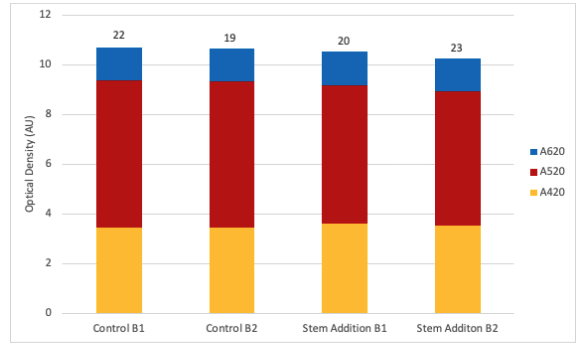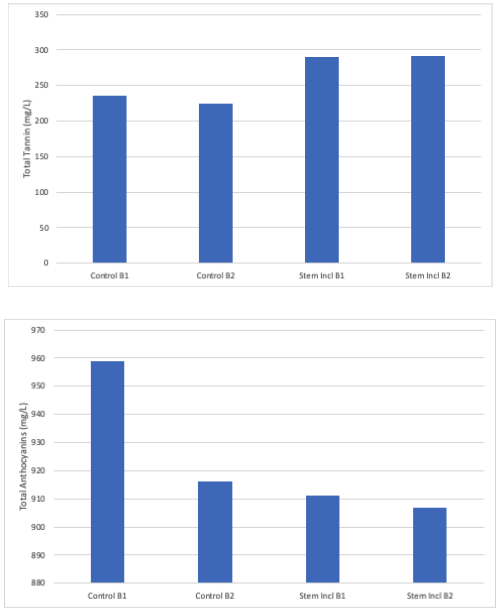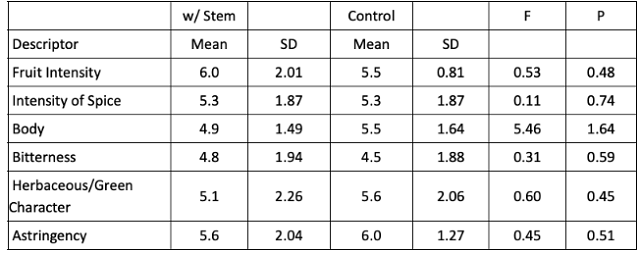Exploring stem inclusion in Chambourcin (2021)
Doug Fabbioli and team
Fabbioli Cellars
Summary
Over the past several years, Doug Fabbioli has been exploring winemaking approaches to produce a high-quality varietal wine from Chambourcin. One approach to increase phenolics is the inclusion of stems. There were two treatment conditions in this experiment. In the control, fruit was destemmed and lightly crushed. In the treatment, fruit was destemmed and lightly crushed and 50% of the stems from control were layered into the treatment bin during processing. In the finished wine, the wine made with stem inclusion had higher pH, lower TA, and lower acetic acid than the control wine. Stem inclusion also led to higher total tannin. The wines were different in a triangle test, but none of the scored descriptors were significantly different.
Introduction
Over the past several years, Doug Fabbioli has been exploring winemaking approaches to produce a high-quality varietal wine from Chambourcin. Chambourcin is a highly colored red grape with loose clusters and reasonable resistance to bunch rot, powdery mildew and some resistance to downy mildew1. These characteristics combine to produce a variety with a fair amount of vintage consistency and potential for economic efficiency in the vineyard. In the winery, Chambourcin can be challenging as a varietal wine. The variety can have a distinct aroma and herbaceous flavor, immature tannins, and high acid content relative to Vinifera species. Lack of tannin can also lead to color instability over time2,3.
One approach to increase phenolics is the inclusion of stems. Stems can make up 2-5% of the overall weight of the grape cluster and their presence has an impact on fermentation in both physical and chemical ways4. Stems also contain extractable phenolics, which can be seen as a benefit or detriment depending on the wine. Paul Draper from Ridge Vineyards avoids using stems in his Cabernet Sauvignon and Zinfandel, as he feels he already has an abundance of tannin4. However, others, like Matthieu Finot of King Family Vineyards, use whole clusters to add to the tannin profile (personal communication), especially in varieties that lack them. These tannins, though challenging in young wines, soften over time to show silky texture and add spiciness to the wine, adding to its ageability4. This is probably why whole cluster fermentation is often applied to low tannin varieties like Pinot Noir and Syrah4.
Inclusion of stems also has other effects. Physically, stems are found interspersed among skins and seeds in the cap, loosening compaction. This allows better mixing during cap management and less stratification of temperature in the fermentation. Generally, these fermentations are characterized by greater retention of volatiles that give varietal character, and gentler extraction of seed phenolics4. Chemically, stems add potassium, which can lead to high pH as potassium binds with tartaric acid to form insoluble bitartrate. Chambourcin tends to be high in acid, so this effect may be a benefit rather than drawback. Stems also contain methoxypyrazine (over 50% of the pyrazine in grape clusters are found in the stems5) that can lead to vegetal/herbal notes.
There are several reasons to add stems separately rather than adding whole clusters, which contain stems. Whole cluster addition leaves whole berries that undergo autofermentation, leading to bright fruit flavors. At Fabbioli, the target wine style for Chambourcin is spicy rather than fruity, so stem addition is a better approach. Autofermentation also does not generally allow as much alcoholic extraction from skins, another source of phenolics. Whole clusters also often introduce air pockets into the fermentation, leading to potential spoilage.
Several previous WRE experiments have been conducted on both whole cluster fermentations and stem inclusion. Taken as a whole, interventions with less than 50% whole cluster inclusion seemed to not make a discernible difference in sensory panels. As a group, including stems, either as whole clusters or stems alone, increased the catechin fraction of phenolics, as well as tannin in some cases. Color generally decreased as did anthocyanins.
The purpose of this experiment was to determine the chemical and sensory effects of adding stems back to a Chambourcin fermentation in hopes of increasing phenolics and mouthfeel without adding bitterness and herbal character. The wine could serve as a “reserve” wine, or as a blending tool to improve color and tannin in a larger Chambourcin lot. There were two treatment conditions in this experiment. In the control, fruit was destemmed and lightly crushed. In the treatment, fruit was destemmed and lightly crushed and 50% of the stems from control were layered into the treatment bin during processing.
Methods
Fruit was hand harvested and refrigerated overnight before processing. On the day of processing, grapes were destemmed and crushed into TBins with the addition of 80 ml/ton Color Pro, 30 g/hL FT Rouge, 1 lb/ton medium toast French oak chips, and 25 ppm SO2. For the stem addition bin, 50% of the stems were added back to the bin in layers. Must was inoculated with BM4x4 yeast without cold soak. Chaptalization to raise sugar by 3 °Brix was done after the beginning of fermentation. Fermentation was monitored daily with nutrient addition of Fermaid K at lag phase. Wine was pressed when dry, allowed to settle, then transferred into barrels and inoculated for malolactic fermentation. Progression of malolactic fermentation was monitored by paper chromatography. Wine was racked within weeks of completion of ML with the addition of 0.72 g/L tartaric acid and 45ppm SO2.
Sensory analysis was completed by a panel of 19 wine producers. Wines were presented blind in randomly numbered glasses. Tasters were presented with three wines, two of one type and one of another, and asked to identify which wine was different (a triangle test). There were four tasting groups with the unique wine in the triangle test balanced between groups. Tasters were then asked to score each wine on a scale of 0 to 10 for fruit intensity, intensity of spice, body, bitterness, herbaceous/green character, and astringency. They were also given open ended questions to describe the wines. Results for the triangle test were analyzed using a one-tailed Z test. Descriptive scores were analyzed using repeated measures ANOVA.
Results
Initial fruit chemistry was very similar between the lots (Table 1). Cellar staff at Fabbioli indicated that it was more difficult to punch down the fermentation with stem inclusion, especially in the first half of fermentation. Stems of Chambourcin are long and they created almost a mesh layer that was difficult to break through. Difficulty in punchdowns may lead to greater temperature stratification and less mixing of juice with skins and seeds. Since tannins are associated with skins, and their extraction is governed by concentration gradients, lack of mixing may inhibit some skin tannin extraction.
In the finished wine, the wine made with stem inclusion had higher pH and lower TA than the control wine (Table 2), presumably due to potassium leaching from the stems and precipitating tartaric acid. Chambourcin is generally high in acidity, so this effect may be a benefit in this variety. Final pH values are well within acceptable ranges for red wine.
The wine made with stem inclusion had lower volatile acidity in both barrels, indicating this was not a barrel effect but rather due to activity during fermentation. There was also a small difference in alcohol, most likely due to differences in volume estimation during chaptalization. Color intensity was nearly the same for all barrels (Figure 1). The wine made with stem inclusion had higher tannin levels in both barrels (Figure 2). Total anthocyanins differed more among barrels than among treatments (Figure 2).
In a triangle test, 11 out of 19 respondents were able to distinguish which wine was different, indicating the wines were significantly different (Z=2.03, p= 0.02). There were no significant differences in scores for fruit intensity, intensity of spice, body, bitterness, herbaceous/green character or astringency (Table 3). In open ended questions, several respondents noted greener tannins and higher acidity in the control than the stem inclusion wine.
Table 1: Juice chemistry for two treatments of Chambourcin (VaTech Enology Services Lab, frozen sample)

Table 2: Wine chemistry for two treatments of Chambourcin (ICV Labs)

Figure 1: Color intensity for two treatments of Chambourcin (ICV labs). Free SO2 (ppm) at the time of color measurement is listed on the top of each column.

Figure 2: Phenolics for two treatments of Chambourcin (ETS Labs)

Table 3: Statistical analysis for descriptive scores from blind sensory analysis of Chambourcin

References
(1) Wolf, T. K. Wine Grape Production Guide for Eastern North America; Plant and Life Sciences Publishing: Ithaca, New York, 2008.
(2) Robinson, J.; Harding, J.; Vouillamoz, J. Wine Grapes: A Complete Guide to 1368 Vine Varieties, Including Their Origins and Flavours, Illustrated Edition.; The Penguin Group: New York, 2012.
(3) Wine Grape Production Guide for Eastern North America; Wolf, T. K., Natural Resource, Agriculture, and Engineering Service, Eds.; NRAES; Natural Resource, Agriculture, and Engineering Service (NRAES) Cooperative Extension: Ithaca, N.Y, 2008.
(4) Goode, J. Stemming the Tide. The World of Fine Wine 2012, No. 37, 90–97.
(5) Zoecklein, B. W. Herbaceous Character in Red Wines. Enology Notes, 2006.
